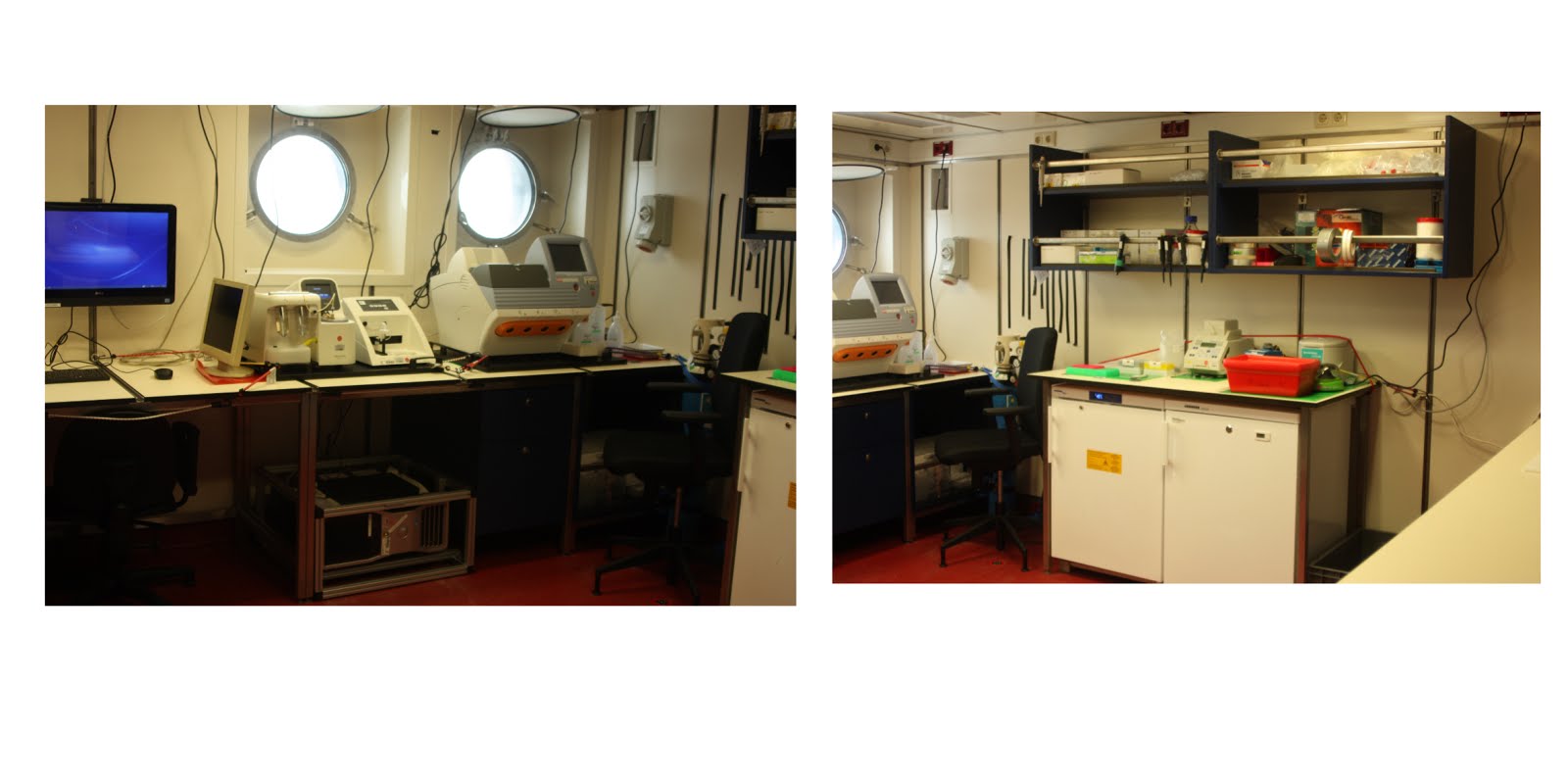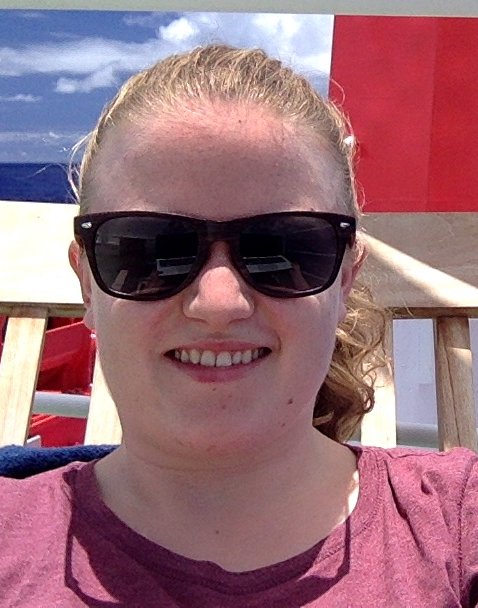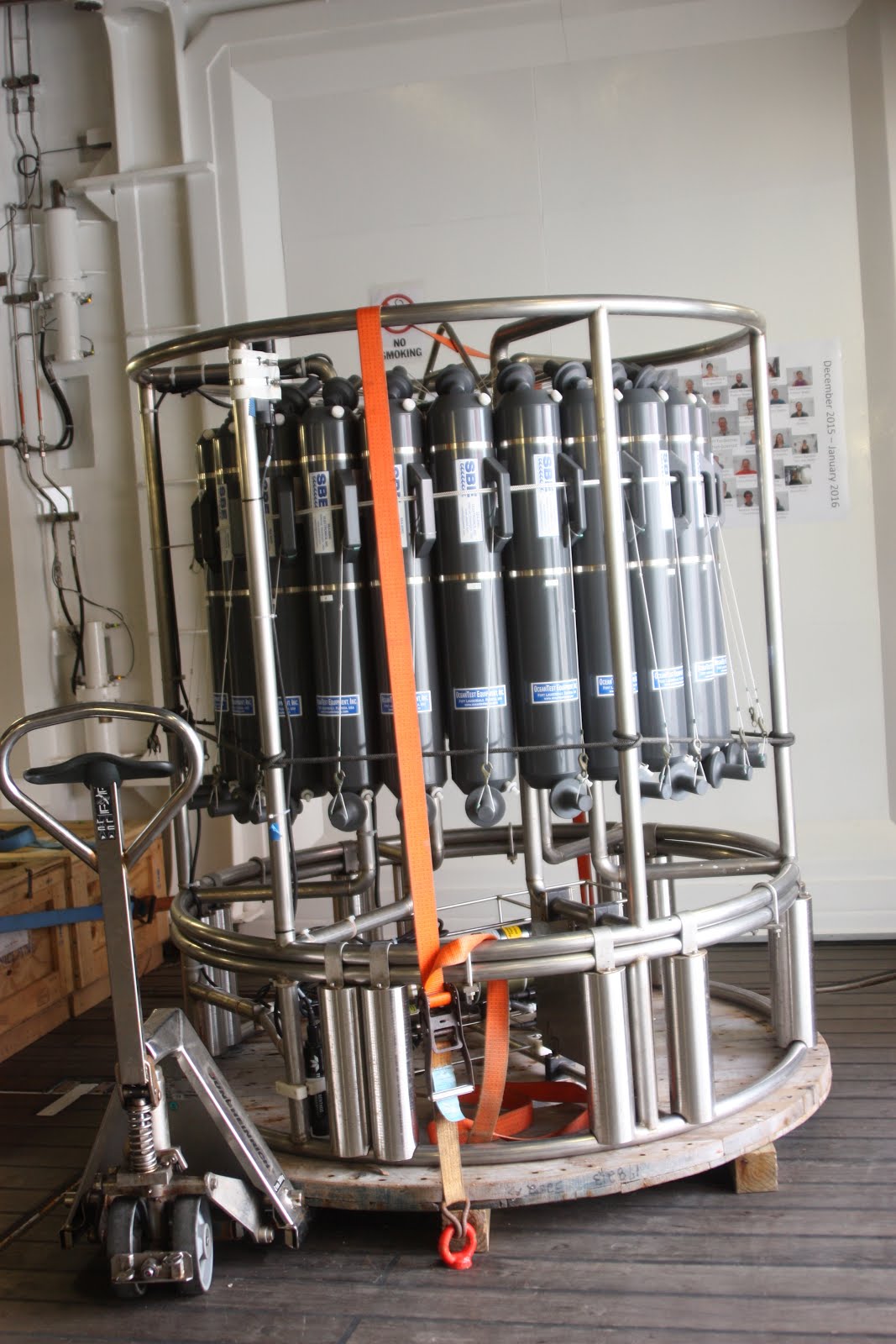Page path:
- Press Office
- 06.01.2016 Ultrapac: Across the Pacific Ocean
06.01.2016 Ultrapac: Across the Pacific Ocean
Today on 6 January 2016 we got the third message from the Sonne Crew.
Greta writes:
"Day to Day Life on the RV Sonne
We (33 scientists and 31 crew) currently live on the RV Sonne. Here is a peek into our day to day life following the only thing that stays the same: the dining schedule.
Lets start at breakfast (7:00-8:00 am).
Assuming that it is normal day with no early sampling, which is a bit of an assumption because when you are on a scientific cruise sampling can happen at any time day or night. There are no standard working hours, wherever there is a planned sampling station we stop, no matter what the time. Anyway, assuming it is a normal day we go to the 4th deck for breakfast.
Breakfast is excellent and there is much to choose from. There are your standard eggs (fried, boiled, scrambled), toast and breads, cheeses, meats, fruits, cornflakes and muesli, coffee, tea and juice. On special days there are treats, for example, today we had Weisswurst und Brezel a nice bavarian breakfast option. After breakfast the work starts. If luck is on our side we would reach a station just after breakfast (unlikely, but we can always hope) and then most of us would head to the hangar to await the CTD. One of the first things that we do when we reach a sampling station is cast a CTD. CTD stands for conductivity, temperature, depth. A CTD/Rosette consists of a rosette of niskin bottles which are winched down to a certain depth and then brought back up. On the way down (and up) it records data such as conductivity, temperature and depth (hence the name) but also fluorescence, light, salinity, oxygen etc. On the way up the bottles are fired to close at specific depths. Then the water from that depth is brought up to the surface and we sample and analyse the water. That way we have water from many depths. On intermediate station we sample from 0 - 500 m and on main stations we sample from 0 - 4000 m (or as deep as we can go). We all await the CTD eagerly with our diverse array of sampling bottles.
As Clara mentioned before there is a precise order to the sampling of a CTD. Every drop of water is precious, it is not everyday routine you get a Pacific water sample from 3500 m depth. The order is devised based on the different sample type. For example gases like helium and oxygen are sampled first, then comes the nutrients and trace metals, then the CDOM, chlorophyll (Chl a) and last but not least the biology samples. To keep the order we make a budget for every CTD, with precise quantities for every person. After we have all obtained our precious water we process it. Everyone has their own techniques based on what their analysing. I, for example, filter my water through a filter with a very small pore size (0,2 µm) trapping all the cells. I then use this filter in for further analysis (more to come).
Lunch is from 11:30 to 12:30 and is a warm meal with a dessert. Today, for example, we had Rinderroulade with Knoedel and Rotkohl and ice cream for dessert. Most of us try to process our samples so that we make it to lunch on time but this is highly dependent on what we are analysing. Some people need to process the water straight away where as other can simply store it away for later analysis. For me this processing is getting easier as there are fewer and fewer cells in the water, which I am filtering, resulting in a much quicker filtration. When we reach a station the first thing we do is cast a CTD. However, work does not stop there, a consecutive set of samples are take through out the day. Therefore, as we “CTD samplers”are processing our water, others are working on UV and optic profilers, alternative water sampling methods such as Go-Flow bottle, Pump CTDs and in situ pump systems. On main stations we cast several CTDs through out the day and there is much work to be done.
The Coffee / Coffee and cake breaks. Welcome breaks are the two coffee breaks one in the morning at 10:00 and one at 15:00 with cake. Especially for those people who miss a meal due to sampling, this is a great chance to get a bite to eat and have a chat. As our cruise has had a few initial delays we have had to change the planning a little and the best way to discuss this is in scientific meetings. Often all the scientists meet in the conference room just after the 15:00 break and we discuss such things as sampling site, water budgets of the CTDs, initial results and any encountered problems.
Dinner is from 17:30 to 18:30. After a long day of sampling and working in the lab we head to dinner. Today it is burritos. At home the work day would finish before dinner and then we all have a relaxing evening to look forward to, but that´s not cruise life. We head back into the labs or start on our data analysis. On some days we even head back into the hangar to wait for the next CTD or other samples.
Greta writes:
"Day to Day Life on the RV Sonne
We (33 scientists and 31 crew) currently live on the RV Sonne. Here is a peek into our day to day life following the only thing that stays the same: the dining schedule.
Lets start at breakfast (7:00-8:00 am).
Assuming that it is normal day with no early sampling, which is a bit of an assumption because when you are on a scientific cruise sampling can happen at any time day or night. There are no standard working hours, wherever there is a planned sampling station we stop, no matter what the time. Anyway, assuming it is a normal day we go to the 4th deck for breakfast.
Breakfast is excellent and there is much to choose from. There are your standard eggs (fried, boiled, scrambled), toast and breads, cheeses, meats, fruits, cornflakes and muesli, coffee, tea and juice. On special days there are treats, for example, today we had Weisswurst und Brezel a nice bavarian breakfast option. After breakfast the work starts. If luck is on our side we would reach a station just after breakfast (unlikely, but we can always hope) and then most of us would head to the hangar to await the CTD. One of the first things that we do when we reach a sampling station is cast a CTD. CTD stands for conductivity, temperature, depth. A CTD/Rosette consists of a rosette of niskin bottles which are winched down to a certain depth and then brought back up. On the way down (and up) it records data such as conductivity, temperature and depth (hence the name) but also fluorescence, light, salinity, oxygen etc. On the way up the bottles are fired to close at specific depths. Then the water from that depth is brought up to the surface and we sample and analyse the water. That way we have water from many depths. On intermediate station we sample from 0 - 500 m and on main stations we sample from 0 - 4000 m (or as deep as we can go). We all await the CTD eagerly with our diverse array of sampling bottles.
As Clara mentioned before there is a precise order to the sampling of a CTD. Every drop of water is precious, it is not everyday routine you get a Pacific water sample from 3500 m depth. The order is devised based on the different sample type. For example gases like helium and oxygen are sampled first, then comes the nutrients and trace metals, then the CDOM, chlorophyll (Chl a) and last but not least the biology samples. To keep the order we make a budget for every CTD, with precise quantities for every person. After we have all obtained our precious water we process it. Everyone has their own techniques based on what their analysing. I, for example, filter my water through a filter with a very small pore size (0,2 µm) trapping all the cells. I then use this filter in for further analysis (more to come).
Lunch is from 11:30 to 12:30 and is a warm meal with a dessert. Today, for example, we had Rinderroulade with Knoedel and Rotkohl and ice cream for dessert. Most of us try to process our samples so that we make it to lunch on time but this is highly dependent on what we are analysing. Some people need to process the water straight away where as other can simply store it away for later analysis. For me this processing is getting easier as there are fewer and fewer cells in the water, which I am filtering, resulting in a much quicker filtration. When we reach a station the first thing we do is cast a CTD. However, work does not stop there, a consecutive set of samples are take through out the day. Therefore, as we “CTD samplers”are processing our water, others are working on UV and optic profilers, alternative water sampling methods such as Go-Flow bottle, Pump CTDs and in situ pump systems. On main stations we cast several CTDs through out the day and there is much work to be done.
The Coffee / Coffee and cake breaks. Welcome breaks are the two coffee breaks one in the morning at 10:00 and one at 15:00 with cake. Especially for those people who miss a meal due to sampling, this is a great chance to get a bite to eat and have a chat. As our cruise has had a few initial delays we have had to change the planning a little and the best way to discuss this is in scientific meetings. Often all the scientists meet in the conference room just after the 15:00 break and we discuss such things as sampling site, water budgets of the CTDs, initial results and any encountered problems.
Dinner is from 17:30 to 18:30. After a long day of sampling and working in the lab we head to dinner. Today it is burritos. At home the work day would finish before dinner and then we all have a relaxing evening to look forward to, but that´s not cruise life. We head back into the labs or start on our data analysis. On some days we even head back into the hangar to wait for the next CTD or other samples.
My laboratory. Everything is stored safely.
Life on a ship is very different from home. There are no fixed working hours and routines, from day to day everything can change. On some days the first sample is at 14:00 and on others it at 4:00 in the morning. Some days we work the whole day through and into the night where as on others we work the whole night and sleep during the day. On steaming days (traveling from station to station) when we are not processing samples and analysing data we have time to enjoy the sunshine in a hammock or watch the most amazing sunsets or sun rises. Its quite an experience seeing sunsets as amazing as those over the pacific ocean and once the sun is down a gazillion stars come out and squid pay around our lights in the water.
Currently we have calm seas and great weather, the water temperature is
25°C and the air has 30°C. Let us hope for further smooth sailing :)
Greetings from the South Pacific Gyre
Greta Reintjes"
Contact:
Dr. Manfred Schloesser
Press officer
Tel.: +49 421 2028 704
Mail: mschloes(at)mpi-bremen.de
Dr. Fanni Aspetsberger
Press officer
Tel.: +49 421 2028 645
Mail: faspetsb(at)mpi-bremen.de
Currently we have calm seas and great weather, the water temperature is
25°C and the air has 30°C. Let us hope for further smooth sailing :)
Greetings from the South Pacific Gyre
Greta Reintjes"
Contact:
Dr. Manfred Schloesser
Press officer
Tel.: +49 421 2028 704
Mail: mschloes(at)mpi-bremen.de
Dr. Fanni Aspetsberger
Press officer
Tel.: +49 421 2028 645
Mail: faspetsb(at)mpi-bremen.de




